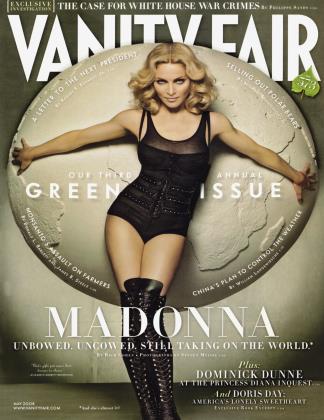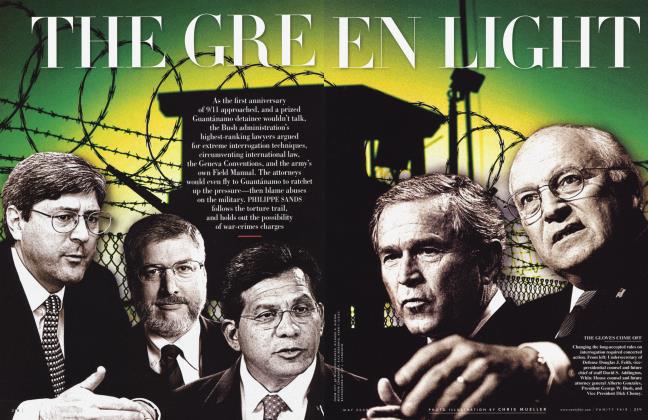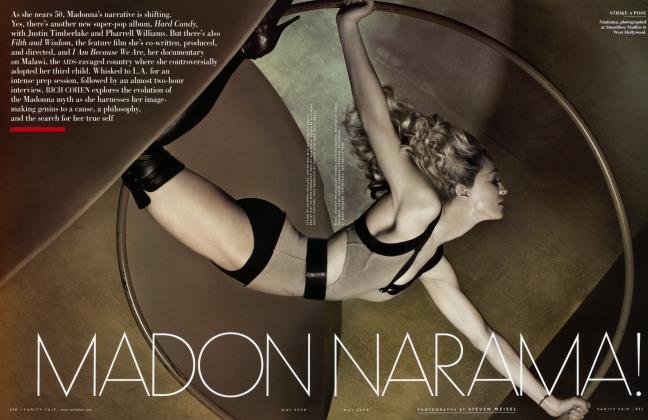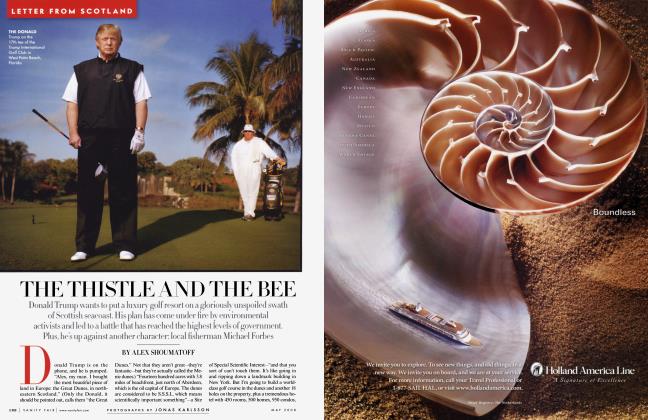Sign In to Your Account
Subscribers have complete access to the archive.
Sign In Not a Subscriber?Join NowCONTRIBUTORS
KOIKM I F. Kennedy Jr.
Robert F. Kennedy Jr. returns to Vanity Fair’s Green Issue to present the presidential candidates with their most urgent environmental challenge: eliminating America’s deadly reliance on fossil fuels. In his manifesto, “The Next President’s First Task,” Kennedy compares our dependence on oil to Great Britain’s exploitation of slavery 200 years ago and predicts that our cessation of fossil-fuel use will instigate an explosion of economic prosperity. “We need to bring back free-market competition in America,” Kennedy says. “We need to re-rig marketplace rules to reward good behavior—efficiency and innovation—and punish bad behavior—waste and profligacy—and release America’s entrepreneurial energies to escape the ball and chain of carbon dependence.” Kennedy and his daughter Kick can be seen in MacGillivray Freeman Films’ new Imax movie, Grand Canyon Adventure: River at Risk.
Philippe Sands
his article “The Green Light” (page 218), Philippe Sands argues that high-level Bushadministration officials embraced abusive techniques of interrogation at Guantanamo Bay long before the ugly images of Abu Ghraib became public. “I couldn’t properly understand how lawyers with extensive experience, trained at Harvard and other such institutions, and coming from a country committed to the rule of law could sign off on methods amounting to torture,” Sands says. “I wanted to get to the bottom of the story.” An international lawyer at the firm Matrix Chambers and a professor at University College London, Sands has written several books. His article in this issue, his first for Vanity Fair, is based on several years of reporting. A full account will appear in Torture Team: Rumsfeld’s Memo and the Betrayal of American Values (Palgrave Macmillan), out this month.
Donald L Barlett and James B. Steele
If the Vanity Fair enterprisereporting team of Barlett and Steele knock on your door, chances are there’s trouble brewing. Since joining V.F., Donald Barlett and James Steele have exposed the nefarious inner workings of the government contractor Science Applications International Corporation (“Washington’s $8 Billion Shadow,” March 2007) and the Coalition Provisional Authority’s egregious “loss” of planeloads of shrink-wrapped cash in Iraq (“Billions over Baghdad,” October 2007). For “Monsanto’s Harvest of Fear,” page 156, the two-time Pulitzer winners investigate Monsanto, the St. Louis-based agribusiness giant that’s become the king of genetically modified seeds. “Monsanto is remaking agriculture with its seeds,” says Steele. “But we had no idea of how disliked the company has become in farm country.” The team learned that the antipathy stems from the aggressive tactics Monsanto employs to protect its seed patents. “If you had told us at the start that this company pays private eyes to secretly videotape farmers, we wouldn’t have believed it.” Steele says the story marks a first for the team: “We’ve never written about a company where some of its own customers are scared of it.”
CONTINUED ON PAGE 68
CONTINUED FROM PAGE 64
Steven Meisel
This month’s cover shoot served as a reunion for photographer Steven Meisel and Madonna (pictured here in New York in 1991). Meisel, one of fashion photography’s pre-eminent image-makers and trendsetters since the 1980s, has shot the Material Girl for Vanity Fair, Vogue, Italian Vogue, Rolling Stone, and her book Sex (with Fabien Baron), as well as the Like a Virgin album cover. Meisel calls their work together— since 1984—a “true collaboration,” sharing credit with the pop star in creating the look of a shoot. Meisel’s work has appeared in countless magazines and has been exhibited at museums in the U.S. and abroad, including New York’s Museum of Modern Art. He has also photographed campaigns for Calvin Klein, Prada, Valentino, and Versace.
Alex ShoumaloH
For this year’s Green Issue, seasoned Vanity Fair contributing editor Alex Shoumatoff, pictured here with a Yakut berry picker in Verkhoyansk, Siberia, tackles two stories with very different environmental themes. In “The Thistle and the Bee,” page 188, Shoumatoff chronicles the pandemonium arising from Donald Trump’s plan to build a golf resort on Scotland’s spectacular and partially protected Menie dunes. “The Trumpster is one of my favorite people, and I have been trying to green him. It looks like I may be making some headway,” says Shoumatoff. “And if the Trumpster can be greened, there is hope for mainstream America, which still doesn’t get it.” His second piece, “The Arctic Oil Rush,” page 230, details the scramble for the Arctic and its vast oil reserves, which its fast-melting ice cap is making accessible. Shoumatoff’s debut music album. Suitcase on the Loose, is slated for release this spring.
Michael Shnayerson
Longtime contributing editor Michael Shnayerson’s interest in polar bears (“The Edge of Extinction,” page 246) came by way of his 13-year-old daughter. At the age of three, she announced that when she grew up she wanted to he a polar bear. Currently, she has polar-bear sheets and pillows and has written several papers on the animal for school. Shnayerson wrote this piece for all polar-bear-enchanted children in whose lifetimes the species may go extinct if serious measures aren't taken to curb the fossil-fuel emissions melting the ice under them. His latest book, Coal River, chronicles the ongoing struggle of a gutsy environmental lawyer and grassroots activists trying to save Appalachia from the ravages of mountaintop-removal coal mining.
CONTINUED ON PAGE 74
CONTINUED FROM PAGE 68
Wayne Lawson
Executive literary editor Wayne Lawson has been with Vanity Fair since its 1983 relaunch, and in addition to editing several of V.F. s regular writers— including Marie Brenner, Maureen Orth, Bob Colacello, John Richardson, and Mark Seal—he also selects many of the book excerpts that appear in the magazine. It can be a challenge to weave sometimes disparate sections of a lengthy manuscript into a concise, readable magazine article. For this issue Lawson chose the material from David Kaufman’s forthcoming biography of Doris Day (“Doris Day’s Vanishing Act,” page 254) and edited Matt Tyrnauer’s articles on architects William McDonough (“Industrial Revolution, Take Two,” page 142) and Renzo Piano (“Natural Phenomenon,” page 242).
Malt Tyrnauer
This month Vanity Fair special correspondent Matt Tyrnauer explores the daring visions of two architects: William McDonough, perhaps the leading figure of the green-design revolution, and Renzo Piano, the global powerhouse who has long been concerned with incorporating natural surroundings and sustainability into his work. “What Le Corbusier was to the modern movement, McDonough is to the sustainable movement, which is the future of design,” says Tyrnauer. “He could be a household name within a few years, because he has a plan of action to save the planet that is not only elegant but seemingly very possible.” The iconic work of Piano, meanwhile, “has long been focused on design that is sensitive to its place. Piano was green before there was green.” Tyrnauer recently finished directing his first film, a documentary about fashion designer Valentino, which will be released later this year.
Subhankar Banerjee
After spending two and a half weeks in the Russian Arctic, where temperatures hovered around 55 degrees below zero during the day, Indian-born photographer-educator-activist Subhankar Banerjee (seen here to the right of his longtime Inupiat friend from Alaska, Robert Thompson) returned from his first trip to Siberia with three frostbitten fingers and the photographs that accompany Alex Shoumatoff’s piece “The Arctic Oil Rush.” Accustomed to working in regions where the extreme cold freezes the batteries and impedes the technology of modern cameras, Banerjee used the only model that he knew would function in such a climate: an outdated, fully mechanical, medium-format camera. “I just hope this article brings awareness to the struggles of the indigenous communities of the Siberian Arctic,” he explains. Banerjee’s photographs of Alaska’s Arctic National Wildlife Refuge were exhibited at the Smithsonian’s National Museum of Natural History in 2003, and he has a solo exhibition and two group shows opening this spring in New York City.
CONTINUED ON PAGE 76
CONTINUED FROM PAGE 74
Cullen Murphy
Since joining the magazine’s ranks, two years ago, editor-at-large Cullen Murphy has cast his skillful eye over a wide range of articles, including William Langewiesche’s National Magazine Awardwinning piece “Rules of Engagement” (November 2006). This month, Murphy worked with Langewiesche again, as well as with writers Philippe Sands, Robert F. Kennedy Jr., and Donald L. Barlett and James B. Steele. “One of the great satisfactions of working at this magazine,” Murphy says, “is the chance to match writers of this caliber with a range of subject matter that virtually has no boundaries.” The Boston-based Murphy was the managing editor of The Atlantic prior to assuming his post at Vanity Fair. His latest book is Are We Rome? The Fall of an Empire and the Fate of America (Houghton Mifflin).
Todd Eberle
Vanity Fair photographer-atlarge Todd Eberle traveled to San Francisco for this month’s issue to shoot the new home of the California Academy of Sciences, designed by acclaimed architect Renzo Piano. Unlike any other structure, the building will contain a natural-history museum, an aquarium, and a planetarium, and will feature one of the nation’s largest “living roofs,” composed of 1.7 million plants. “In the countless buildings I’ve seen, sometimes a brand-new architecture appears, as if by magic. The academy is one of those,” Eberle says. “It’s not always evident to me what qualities are ‘green’ in ‘green architecture,’ but Renzo has set the standard. It’s hard to imagine any future building without a landscaped roof.” Eberle’s photographs can be viewed at the “Vanity Fair Portraits: Photographs 1913-2008” show at the National Portrait Gallery and, in April, at the “Skin & Bones” exhibition at Somerset House, both in London.
David Kaufman
“As many books as there have been about Doris Day,” says author David Kaufman, “much of her life is mysterious.” In his biography of the actress and singer, excerpted in this issue (“Doris Day’s Vanishing Act”), Kaufman unearths the facts about Day’s life and re-examines her career. “She has been underestimated and undervalued by the culture,” he says. “She made a lot of schlock later in her career, but she continued to have her special gifts.” A lifelong Day fan, Kaufman interviewed more than 175 people in the course of his research for Doris Day: The Untold Story of the Girl Next Door, which will be published next month by Virgin Books. “Being a biographer is not only being a detective,” he says. “It’s also an obsession.”
 View Full Issue
View Full Issue






Subscribers have complete access to the archive.
Sign In Not a Subscriber?Join Now